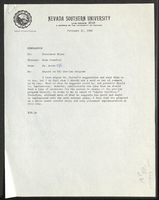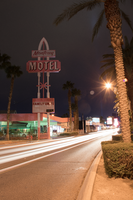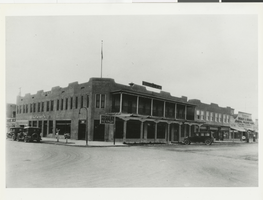Search the Special Collections and Archives Portal
Search Results
William J. Moore Jr. Photograph Collection
Identifier
Abstract
The William J. Moore Jr. Photograph Collection (approximately 1942-1960) consists of black-and-white photographic prints, negatives, and one oversize image depicting William "Bill" J. Moore Jr.'s career as a casino operator in Las Vegas, Nevada. Images include events at the Moore family home and the Hotel Last Frontier. Also included are images of Moore with politicians, casino operators, and other notable figures in Las Vegas.
Archival Collection
The Vista Group Records
Identifier
Abstract
The Vista Group records are comprised of The Vista Group's legal, financial, and correspondence records from 1986 through 2001. The records include information about real estate developments The Vista Group was involved with in Las Vegas, Nevada. The majority of the records are financial and legal documents related to The Vista Group's ventures.
Archival Collection
Houssels Photograph Collection
Identifier
Abstract
The Houssels Photograph Collection contains color and black-and-white photographs and slides of the Houssels House from 1983. The photographs document the house's original location on Sixth Street in Las Vegas, Nevada, and its subsequent transportation to the University of Nevada, Las Vegas campus.
Archival Collection

Nevada Southern University law program: reports and correspondence
Date
Archival Collection
Description
Folder contains memorandums, correspondence related to the law program at Nevada Southern University (later UNLV). It includes a report on the NSU law program (fall term 1967-1968), a report of the Association of American Law Schools Committee on Guidelines for New Law Schools (1966), and a report of Dean Willard H. Pedrick, Arizona State University College of Law (1967). From the University of Nevada, Las Vegas William S. Boyd School of Law Records (UA-00048).
Text

Photographs of Monterey Motel sign, Las Vegas (Nev.), February 12, 2017
Date
Archival Collection
Description
Site address: 1133 S Las Vegas Blvd
Sign owner: Monterey Motel Corp.
Sign details: The building was constructed in 1944 (Assessor). The business opened as the Monterey Lodge Motel (RoadsideArchitecture). A vintage postcard from 1954 shows The Monterrey Lodge Motel with much of the current architecture, although a different sign is present (Las Vegas motels then and now). The motel advertises itself as endorsed by several automobile clubs, including the Automobile Association of America (AAA).
Sign condition: Condition is 4, good. The cabinets, light boxes and neon are intact and in good condition. The paint shows slight fading and no flaking or peeling, except for light to moderate deterioration and rust on the bottom of the lower cabinet.
Sign form: Double pole sign
Sign-specific description: Double poles painted in bands of pink topped by bands of white support a rectangular reader board with a pink metal cabinet. Plastic pink sans serif letters spell out "FAMILY UNITS" on the face of the readerboard. On the lower motel side of the readerboard is a rectangular black plastic sign which states, "COLOR TV by RCA" in multi-colored san serif letters. At the top of the cabinet on the motel side is an arrow pointing toward the business. At the top of the north face of the cabinet is white coated skeleton neon tubing which states, "ENTER NO VACANCY" in sans serif letters. On the south face of the cabinet the lettering is reversed to say, "NO VACANCY ENTER". Mounted above the readerboard are three poles. The two outside poles are painted white and consist of round pedestals, shafts and capitals. The capitals are outlined in white skeleton neon. The rectangular interior pole is painted pink. A pink, rectangular bar (from an asterisk now covered by plastic wrap advertising) intersects the middle of all three poles. A rectangular shield shaped metal cabinet painted pink sits on the poles above the readerboard. White sans serif letters outlined in black paint and clear skeleton neon spell out "MOTEL". The three poles continue out of the cabinet to support a second pink metal readerboard which features "Monterey" spelled in plastic cursive letters. The three poles extend above the second reader board where they join to make an arch. The two outside poles are outlined in white skeleton neon.
Sign - type of display: Neon and Reader boards
Sign - media: Steel and Plastic
Sign - non-neon treatments: Reader boards
Sign environment: This is located on Las Vegas Boulevard South just north of the strip.
Sign - date of installation: Circa 1950's-1960's (RoadsideArchitecture)
Sign - date of redesign/move: A 2009 photograph shows the sign painted blue (Virus, 2009). Flaking paint under the "COLOR TV by RCA" sign shows an older layer of blue paint. A sign of similar age in the parking lot of the motel is still painted the same light blue shown in the photograph.
Sign - thematic influences: There is a Googie star on the sign as well as an arch which was a popular 1950's/60's sign design. Also they advertise automobile clubs on their sign and have a western ranch style building which are also Mid-Century Modern trends as well.
Sign - artistic significance: The sign showcases Googie, Western and motor court artistic aspects.
Survey - research locations: Clark County Assessor, Parcel No. 162-03-112-034. Retrieved from http://www.clarkcountynv.gov/assessor/Pages/PropertyRecords.aspx?H=redrock&P=assrrealprop/pcl.aspx Las Vegas motels then and now. (n.d.) Monterey Lodge - 1133 South Las Vegas Blvd. Retrieved from http://stefanidrivesvegas.com/8.html RoadsideArchitecture. (n.d.). Monterey Motel. Retrieved from http://www.roadarch.com/signs/nvvegas3.html Virus, R. (2009 April 5). Monterey Motel, Las Vegas, NV. Retrieved from https://www.flickr.com/photos/25229906@N00/5769946413/in/photostream/
Surveyor: Mitchell Cohen
Survey - date completed: 2017-09-04
Sign keywords: Steel; Plastic; Reader board; Neon; Pole sign; Back to back; Backlit
Mixed Content

Mauricia Baca oral history interview: transcript
Date
Archival Collection
Description
Oral history interview with Mauricia Baca conducted by Claytee D. White on March 7, 2019 for the Remembering 1 October Oral History Project. Mauricia Baca discusses her early life, her education, and her experiences living in New York City, New York before she moved to Las Vegas, Nevada. She also relates her experiences on and after the 1 October mass shooting. Baca relates information on her agency, Get Outdoors Nevada. Baca shares how her agency worked with the City of Las Vegas in the construction and operation of the Healing Garden. Finally, she discusses the book she helped author regarding 1 October.
Text

Margie Llorente Gonzales oral history interview: transcript
Date
Archival Collection
Description
Oral history interview with Marietta "Margie" Llorente Gonzales conducted by Cecilia Winchell, Vanessa Concepcion, and Stefani Evans on November 1 and 22, 2021 for Reflections: The Las Vegas Asian American and Pacific Islander Oral History Project. Margie Llorente-Gonzales discusses her upbringing in Manila, the Philippines and her family history within the country, recalling the lives of her parents, grandparents, and great grandparents. She talks about her childhood, educational pursuits, and courtship with her husband in the Philippines. Margie shares how she and her husband immigrated to the United States, how she adapted to her new life as an immigrant dependent on her extended family, and how she and her husband came to settle in Las Vegas. She talks about her artistic pursuits in the forms of dance choreography and performing, scriptwriting, broadcasting, and publishing newsletters. Margie also discusses her employment at McCarran Airport and her political activism, canvassing, and committee work in the Philippines and the United States.
Text

Myron Martin and Don Snyder interviews, November 30, 2017, December 06, 2017, and March 08, 2018: transcript
Date
Archival Collection
Description
Part 1: Interviewed by Stefani Evans. Myron G. Martin, President and CEO, and Donald D. Snyder, Chairman of the Board of Directors, share their memories of the founding of The Smith Center for the Performing Arts from the first non-for-profit foundation formed in 1996. The second iteration led by Snyder in 1999 brought in Martin--former Director of UNLV Performing Arts Center--and created a sustainable business plan for a center for the performing arts that would be accessible geographically and culturally for all segments of Nevada society. Here, Martin and Snyder recall how land, funding, and legislation for The Smith Center depended on the ""power of the project"" and the Snyder-Martin team's ability to overcome skeptics in the public, the Nevada Legislature, the Clark County Commission, the Las Vegas City Council, and the Don Reynolds Foundation. Martin and Snyder satisfied the various requirements for each organization and earned unanimous approval at each stop--in fact, the $50 million donation to The Smith Center was the largest the Don Reynolds Foundation had ever granted largest. That the approvals came on three consecutive days from competing municipal jurisdictions makes the accomplishment even sweeter. Subjects: Las Vegas, NV; Cultural center; Performing arts; The Smith Center for the Performing Arts; The Smith Center; Not-for-profit;; Nevada Legislature; Clark County Commission; Las Vegas City Council; The Don Reynolds Foundation; Fundraising; Planning; Endowment; Part 2: Interviewed by Stefani Evans. Martin, who was the youngest of three boys raised in suburban Houston, Texas, likes to say that in college at the University of North Texas he played for the Atlanta Braves and the Texas Rangers. So he did--as the organist. He earned a Bachelors of Music in piano, organ, and voice and an MBA from Golden Gate University. He came to Las Vegas after a fifteen-year career with the Baldwin Piano Company as executive director of the Liberace Foundation; he later became president of UNLV?s Performing Arts Center and in 1999 he became president of the Las Vegas Performing Arts Center Foundation. Here, Martin and Snyder recall the process whereby they hired architect David Schwarz of Washington, DC, to create The Smith Center's ""timeless, elegant"" look; creating a ""shared vocabulary"" by visiting 14 performing venues in 5 European countries; the City of Las Vegas's RFP that resulted in hiring Whiting-Turner Contracting Company; the exterior art/artists, significance of the bell tower, Founding Fifty(seven), and the ability of the theater to adapt from staging The Book of Mormon to staging a community funeral for two slain police officers. Subjects: The Smith Center; The Smith Center for the Performing Arts; Architecture; Fundraising; Acoustics; Public private partnerships; Request for proposals; Whiting-Turner; Theater Projects Group; vocabulary; Part 3: Interviewed by Stefani Evans. Author Jack Sheehan, joining this third session on The Smith Center in his role as Don Snyder's biographer, explains the way he envisions the place of The Smith Center in the larger context of Las Vegas. Martin and Snyder provide names for the group that grew out of the Call to Action meeting and founded the original Las Vegas Performing Arts Foundation. They share anecdotes of a 2005 trip, wherein they were joined by Las Vegas City Councilman Lawrence Weekly, City of Las Vegas Mayor Oscar Goodman, and consultant to the City of Las Vegas Dan Van Epp to visit City Place and the Kravis Center for Performing Arts in West Palm Beach as an example of a place where a performing arts center was a catalyst for revitalization in an area of underused and underutilized urban land. They discuss opening night, March 10, 2012, /From Dust To Dreams: Opening Night at the Smith Center For The Performing Arts/, which was produced broadcast live on national Public Broadcasting System (PBS) television stations, produced by George Stevens Jr. and directed and produced by Michael Stevens for The Stevens Company; hosted by Neil Patrick Harris; and featuring Jennifer Hudson, Willie Nelson, Merle Haggard, Emmylou Harris, Martina McBride, Carole King, Arturo Sandoval, Joshua Bell, Mavis Staples, Pat Monahan; American Ballet Theater dancers Marcello Gomes and Luciana Paris; also Broadway performers Brian Stokes Mitchell, Laura Osnes, Cheyenne Jackson, Sherie Rene Scott, Montego Glover, and Benjamin Walker. Martin describes how provisions of Nevada SB235--introduced March 6, 2017, signed into law by Governor Bob Sandoval, and became effective October 1, 2017--for the regulation of ticket sales to an athletic contest or live entertainment event affect The Smith Center ticket sales. They talk of providing 3,600 good construction jobs during the recession, of Discovery Childrens Museum, of future development plans for the entire 61-acre Symphony Park parcel, and of a second capital campaign to increase the endowment to $100 million to enable The Smith Center to be economically sustainable.
Text

Photograph of the front exterior of the Hotel Nevada (Las Vegas), circa 1910
Date
Archival Collection
Description
Hotel Nevada after the addition of a balcony. Transcribed from photo sleeve: "by Florence Lee Jones ... March, 1969. Early Las Vegas History. The Hotel Nevada, at the Southeast corner of Main and Fremont Streets, is the oldest continuous hotel business in Las Vegas, although it has been known as Sal Sagev (Las Vegas spelled backward) since 1928. The hostelry started as a tent in 1905, but the late John Miller soon erected a permanent building, shown above, which provided the most luxurious accommodations and the best food in Las Vegas for many years. In the 1930's the Sal Sagev Hotel had one of the three elevators in town. A private dining room was a popular place for private parties for the elite of the town. The hotel is now owned and operated by Miller's son, Abe Miller, and his daughter, Mrs. Sherman E. Nugent. The Golden Gate Club now occupies much of the first floor of the building. On the North side of the building is a sign "Bank of Southern Nevada", which was the second bank established in Las Vegas. (The other was the First State Bank.) Started by John F. Miller, Ed Von Tobel, Sr., Will Beckley, Attorney Frank Stevens, and Hal D. Buzick, the Bank of Southern Nevada was an important factor in Southern Nevada's economy. During the 1930's and the Depression, the federal government issued restrictive orders on bank operations. The reaction of the independent Las Vegans was 'No guy in Washington is going to tell us how to run our bank.' ... So they paid off all the depositors and closed the bank. The Rhoads & Rhoads General Machine Works (extreme right) was one of the first automobile agencies in town - the start of Community Chevrolet."
Site Name: Hotel Nevada
Address: 1 Fremont Street
Image
El Rancho Vegas Collection
Identifier
Abstract
The El Rancho Vegas Collection (1953-1961) is comprised of materials and memorabilia from the El Rancho Vegas Hotel collected by former hotel controller, Frank Watts. Records include financial documents including endorsed checks to performers at the resort. Other items included unused stationary, copies of the menu, and memorabilia from the hotel. The collection also contains a bathmat, hangers, and a drinking glass from the hotel.
Archival Collection
